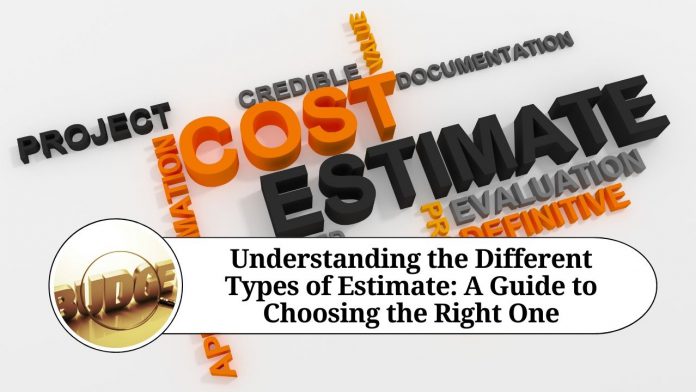Introduction
Estimating is a crucial aspect of many fields, from construction to finance. An estimate is an approximation of a quantity, value, or cost based on available information and analysis. The accuracy of an estimate depends on various factors, such as the quality of the data, the experience of the estimator, and the complexity of the project. In this blog, we will explore the different types of estimates used in various industries.
- Order of Magnitude Estimate: Order of Magnitude Estimate is also known as Rough Order of Magnitude (ROM) or ballpark estimate. It is a preliminary, rough estimate used to gauge the scope and feasibility of a project. This estimate is based on limited information and is typically within a range of plus or minus 50%. Order of Magnitude Estimate is usually used to provide an initial project estimate before more detailed estimates can be created.
- Budget Estimate: Budget estimate is a more refined estimate that is created once the project’s scope and feasibility have been determined. It is based on more accurate data and analysis than the Order of Magnitude Estimate. This type of estimate is used to determine the project’s funding and typically has a range of plus or minus 20%. Budget estimates are commonly used in the construction industry and are often required before funding for a project is approved.
- Definitive Estimate: A definitive estimate is the most precise type of estimate. It is created after the project’s scope and requirements have been defined and all of the necessary information has been collected. This type of estimate is used to determine the actual cost of a project and is usually accurate within plus or minus 10%. Definitive estimates are commonly used in industries such as construction, engineering, and manufacturing, where precision is critical.
- Parametric Estimate: A parametric estimate is based on historical data and statistical analysis. It uses specific parameters, such as the size of the project, the materials needed, and the labor required, to estimate the cost of the project. Parametric estimates are commonly used in industries where there is a lot of historical data available, such as the construction industry. This type of estimate is generally more accurate than Order of Magnitude or Budget Estimates, but less precise than Definitive Estimates.
- Analogous Estimate: An analogous estimate is a type of estimate that is based on similar projects that have already been completed. This type of estimate is often used when there is limited data available or when a project is unique or has no prior history. Analogous estimates are less precise than other types of estimates, but they can still provide a good starting point for project planning.
- Order of Magnitude Estimate: As mentioned earlier, the Order of Magnitude Estimate is a rough estimate that is typically used to provide a quick estimate of a project’s scope and feasibility. It is commonly used in the initial stages of project planning when there is limited information available. This type of estimate is often used in the construction industry, where it is essential to provide clients with an idea of the potential costs involved in a project.
- Budget Estimate: A budget estimate is more refined than an Order of Magnitude Estimate, but it is still considered a preliminary estimate. It is usually created once the project’s scope and feasibility have been determined and is used to determine the funding required to complete the project. This type of estimate is commonly used in the construction industry, where it is often required before funding for a project is approved.
- Definitive Estimate: A Definitive Estimate is the most accurate type of estimate and is created after the project’s scope and requirements have been defined and all necessary data has been collected. This type of estimate is used to determine the actual cost of a project and is typically accurate within plus or minus 10%. Definitive estimates are commonly used in industries such as construction, engineering, and manufacturing, where precision is critical.
- Parametric Estimate: A parametric estimate is a type of estimate that is based on historical data and statistical analysis. It uses specific parameters, such as the size of the project, the materials needed, and the labor required, to estimate the cost of the project. This type of estimate is commonly used in industries where there is a lot of historical data available, such as the construction industry. This type of estimate can be more accurate than Order of Magnitude or Budget Estimates, but it is less precise than Definitive Estimates.
- Analogous Estimate: An analogous estimate is a type of estimate that is based on similar projects that have already been completed. This type of estimate is often used when there is limited data available or when a project is unique or has no prior history. Analogous estimates are less precise than other types of estimates, but they can still provide a good starting point for project planning.
In conclusion
The type of estimate used will depend on various factors, such as the project’s scope, data availability, and industry requirements. The accuracy of an estimate can significantly impact a project’s success, and it is essential to choose the right type of estimate to ensure that the project is completed on time and within budget.
Read more useful content:
- section 234e of income tax act
- section 286 of income tax act
- section 90a of income tax act
- section 40a(7) of income tax act
- section 226(3) of income tax act
- section 24 of income tax act
Frequently Asked Questions (FAQs)
Q1. What is an Order of Magnitude Estimate, and when is it used?
An Order of Magnitude Estimate is a rough estimate that is typically used to provide a quick estimate of a project’s scope and feasibility. It is commonly used in the initial stages of project planning when there is limited information available.
Q2. What is a Budget Estimate, and when is it used?
A Budget Estimate is more refined than an Order of Magnitude Estimate, but it is still considered a preliminary estimate. It is usually created once the project’s scope and feasibility have been determined and is used to determine the funding required to complete the project.
Q3. What is a Definitive Estimate, and when is it used?
A Definitive Estimate is the most accurate type of estimate and is created after the project’s scope and requirements have been defined and all necessary data has been collected. This type of estimate is used to determine the actual cost of a project and is typically accurate within plus or minus 10%.
Q4. What is a parametric Estimate, and when is it used?
A Parametric Estimate is a type of estimate that is based on historical data and statistical analysis. It uses specific parameters, such as the size of the project, the materials needed, and the labor required, to estimate the cost of the project. This type of estimate is commonly used in industries where there is a lot of historical data available, such as the construction industry.
Q5.What is an Analogous Estimate, and when is it used?
An Analogous Estimate is a type of estimate that is based on similar projects that have already been completed. This type of estimate is often used when there is limited data available or when a project is unique or has no prior history.
Q6. How do I choose the right type of estimate for my project?
Choosing the right type of estimate will depend on various factors, such as the project’s scope, data availability, and industry requirements. It is essential to consider these factors and consult with experts to determine which type of estimate is best for your project.
Q7. How important is the accuracy of an estimate?
The accuracy of an estimate can significantly impact a project’s success. Inaccurate estimates can lead to cost overruns, missed deadlines, and other issues that can impact a project’s overall success. It is essential to choose the right type of estimate and ensure that it is as accurate as possible to avoid these issues.
Q8. Can estimates change over time?
Estimates can change over time as more data becomes available or as the project’s scope changes. It is essential to update estimates regularly to ensure that they remain as accurate as possible.




















